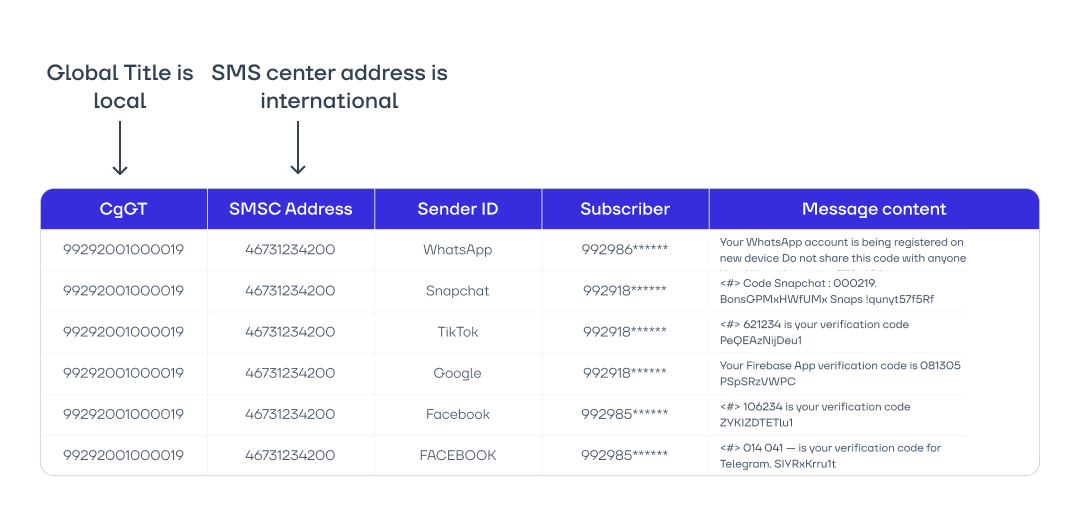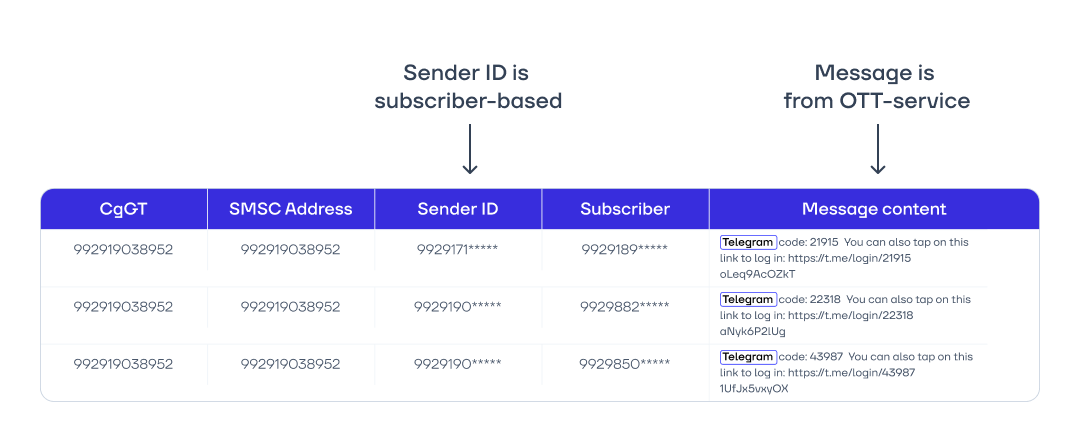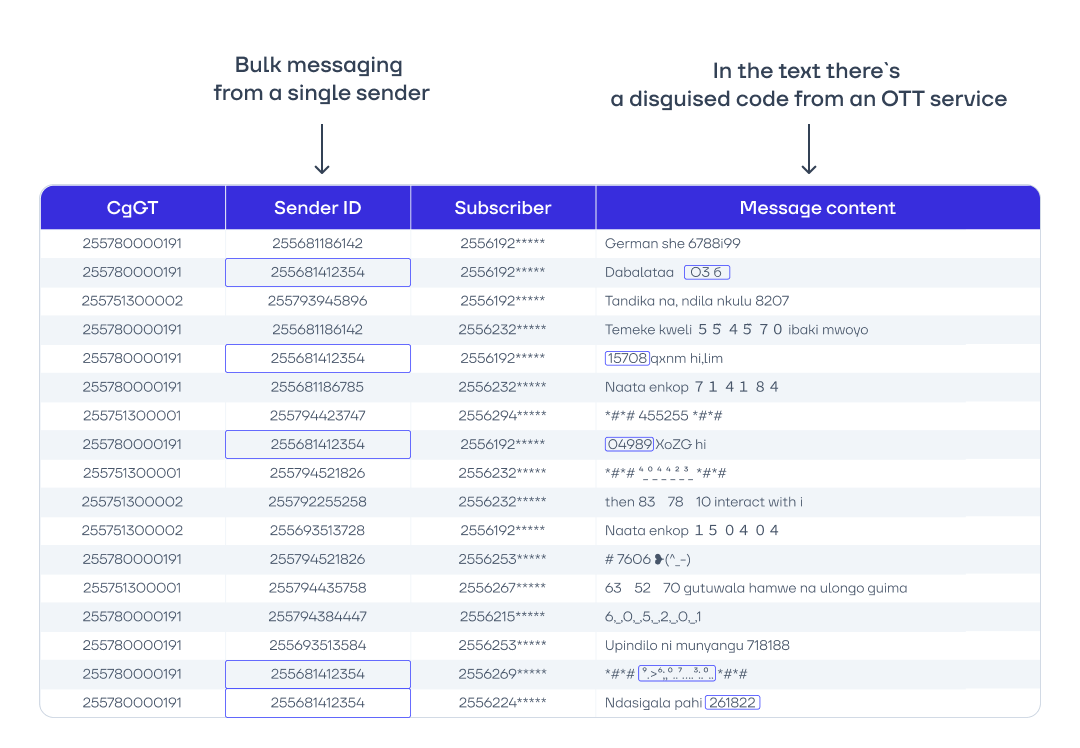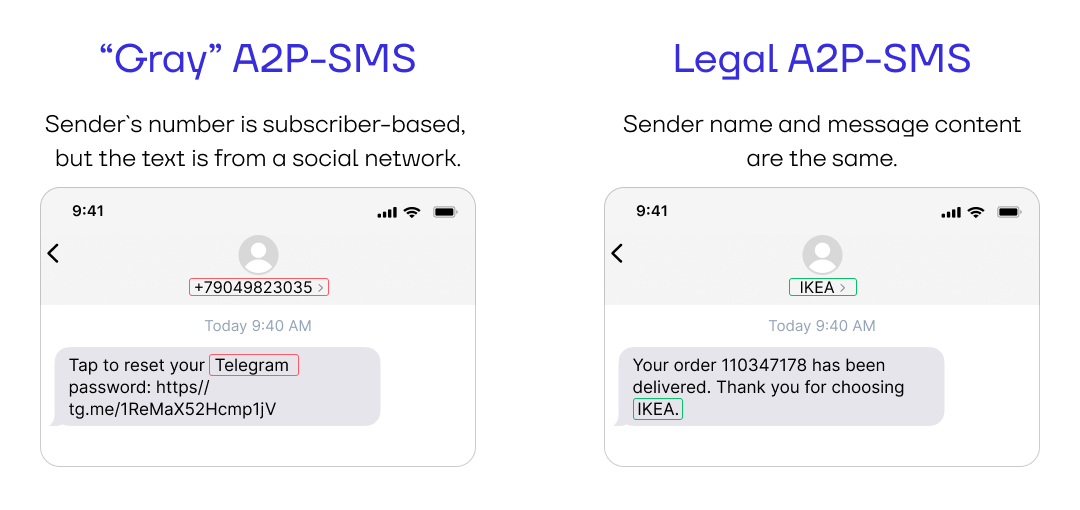How Operators Lose Revenue Due to the Termination of Illegal A2P Traffic

Operator Revenues and Losses from A2P Traffic
A2P SMS is one of the most common forms of communication between businesses and consumers. Services send clients one-time passwords for authentication, medical centers send appointment reminders, delivery companies send package notifications, and online retailers send updates about new collections and promotions.
The popularity of A2P messaging surged after the pandemic, as consumers began relying more heavily on online services. Since then, growth has continued steadily, even though not all companies have adopted this communication channel. Let’s take a look at A2P messaging market trends over the past few years. In 2021, only 7.33% of organizations used SMS to connect with customers; in 2022, that figure rose to 7.98%, and in 2023, it reached 8.52%. According to Mobilesquared forecasts, by 2027, it’s expected to grow to 9.54%.
As the SMS channel gains traction, demand for reliable message delivery is also on the rise. To meet this need, companies turn to SMS aggregators for traffic termination services.
Traffic termination refers to the delivery of SMS messages either from one subscriber to another (Person-to-Person, P2P) or from a service to a subscriber (Application-to-Person, A2P). In the case of A2P traffic, aggregators act as intermediaries, transmitting traffic from companies to telecom operators for delivery to end users. Serving as the link between businesses and operators, aggregators earn money by pocketing the difference between what companies pay for message delivery and what operators charge for transmission. For example, if a company pays an aggregator $0.10 per SMS while the operator charges $0.07, the aggregator makes a $0.03 profit. To increase their margins, aggregators aim to widen this gap—either by raising rates for business clients or by lowering costs in contracts with telecom operators, sometimes using questionable methods.
The Cost of A2P Traffic Termination
In 2023, the average global cost of delivering international SMS messages was $0.07, with the highest rate reaching $0.28. Among 200 operators, prices were higher than the average:- by 50% for 164 operators,
- by 100% for more than 20 operators,
- by 200% for 7 operators.
According to Mobilesquared, the highest traffic termination rates were recorded in the following countries:
- Azerbaijan — $0.24,
- Tajikistan — $0.22,
- Russia — $0.20.
.png)
Average Traffic Termination Cost at the End of 2023 Across 200 Operators Worldwide
Source: A2P SMS Pricing Impact Report. 4Q 2023 Update – Public (Mobilesquared)
The total commercial A2P messaging market is projected to reach $72.18 billion by the end of 2024. By 2033, it is expected to grow to $104.52 billion. For operators, this presents an opportunity to boost profits by monetizing traffic—provided they prevent "gray" route SMS traffic from entering their networks.

The Use of SMS Channels for Commercial Purposes Is the Main Driver of A2P Traffic Growth
Source: The A2P Messaging Market Global Forecast Report 2025 (Business Wire)
Telecom Revenue Leakage due to "Gray" A2P SMS
The impact of illegal traffic on mobile operators lies in the fact that they are missing out on potential revenue due to unscrupulous SMS aggregators and content providers who attempt to cut costs on A2P traffic termination. They send SMS messages through illegal routes to lower the cost per message and boost their profits. As a result, operators lose out on rightful earnings. According to GSMA, 45% of all A2P traffic bypasses legal routes..png)
Source: GSMA Press Release (GSMA)
"To block illegal traffic and help our clients boost their profits, we implement preventive measures, such as using AI to detect SIM boxes. We also monitor clients' international traffic volumes daily and take immediate action if we see a decline: we conduct post-analysis of CDRs, update and test filtering rules and blacklists to block 'gray' A2P SMS routes."
Irina Timofeeva,
Eastwind Customer Success Manager
Types of Fraud in the Commercial Messaging Market
Dishonest aggregators are constantly inventing new ways to illegally deliver messages through mobile networks. Typically, A2P messaging fraud falls into one of three main schemes:
- Masking international SMS as local messages. International traffic is significantly more expensive than local traffic. To profit from this difference, aggregators manipulate MSISDNs and route messages through local operators' networks, bypassing official SMS exchange agreements between domestic operators. The price difference is pocketed by the aggregators.
- Routing SMS through partner operators. Unscrupulous aggregators send A2P traffic not directly to the destination operator, but through other operators offering lower rates. These SMS are then transmitted under inter-operator agreements, which are designed to simplify settlements by allowing operators to pay each other a fixed fee for message delivery—typically much lower than the actual cost based on traffic volume. Since no additional fee is charged per SMS, fraudsters exploit this loophole.
- Using SIM boxes. Fraudsters disguise A2P traffic as P2P by using devices loaded with regular subscriber SIM cards. P2P messages are cheaper than commercial ones, and with prepaid plans, the cost drops even further.

Source: Global A2P SMS Report: The Complete Overview 2017–2027 (Mobilesquared)
Because of aggregator fraud, operators are losing potential revenue, making SMS fraud detection solutions—such as SMS Firewall—more important than ever. These systems analyze all incoming messages, identify signs of illegal delivery routes, and block fraudulent traffic.
Monetize Your A2P Traffic with EW SMS Firewall
Our solution automatically detects and blocks messages delivered through "gray" routes. Eastwind specialists will support you every step of the way toward achieving your KPIs by monitoring traffic and promptly updating SMS filtering rules.
Learn more about the capabilities of EW SMS Firewall
Signs of SMS Fraud
We’ve highlighted the most common examples of fraudulent schemes:
- Sender ID does not match the message sender’s name. An SMS aggregator uses subscriber MSISDNs and national short codes to deliver messages from international OTT services. This allows the aggregator to cut costs, as messages from subscribers are much cheaper than international commercial traffic.
.png)
- The SMSC address does not match the operator’s Global Title. SMS aggregators send international A2P messages through a local operator’s network, bypassing domestic SMS exchange agreements between operators.

- Sender numbers don’t match the SMS content. The aggregator sends messages from international OTT services using subscriber SIM cards with national MSISDNs. This is an example of SIM box fraud in telecom.
Sender numbers don’t match the SMS content. The aggregator sends messages from international OTT services using subscriber SIM cards with national MSISDNs. This is an example of SIM box fraud in telecom.


This is not an exhaustive list, as fraudsters are constantly coming up with new ways to bypass legal traffic delivery routes. To detect fraud in real time, traffic must be continuously monitored and new filtering rules regularly configured. This requires dedicated specialists—some vendors offer them to clients under a Managed Services model. This approach provides full support for operating the SMS Firewall.
"Fraudsters are constantly finding new ways to spoof traffic. Sometimes, in a single day, we block several alphanumeric senders—messages from international services that attackers have disguised as local by altering the sender names. The number of messages from one alphanumeric ID can vary from a dozen to several thousand. But every single one represents a potential loss for the operator. Preventing those losses is our mission."
Irina Timofeeva,
Eastwind Customer Success Manager
How to Prevent A2P Messaging Fraud and Monetize Your Traffic
Anti-"Gray" A2P messaging systems help telecom operators detect dishonest partners, enforce legal traffic termination routes, and ensure proper billing. The SMS traffic legalization and monetization strategies consist of four steps that can be implemented using SMS Firewall.
Step 1: Collect and Analyze Data
SMS Firewall monitors all traffic on the mobile operator’s network—messages from subscribers, to subscribers, and from applications. Based on the data it gathers, the system generates analytical reports on the volume and sources of suspicious traffic.
Step 2: Detect "Gray" A2P SMS
SMS Firewall analyzes messages for inconsistencies between the Sender ID, the sender’s number, and the SMS content. It scans the message text for keywords, phrases, and filter patterns. For example, if the sender’s number is a subscriber MSISDN but the message contains content from an OTT service, it is flagged as fraudulent.

Dishonest aggregators disguise A2P SMS as P2P to reduce costs. EW SMS Firewall detects these schemes
For example, EW SMS Firewall allows you to create both active and passive blacklists based on traffic analysis. Active blacklists include numbers from which SMS fraud has already been detected. Passive blacklists contain numbers that have raised suspicion. To confirm fraudulent activity, specialists first collect statistics and then test new filtering rules on those numbers. If confirmed, the numbers are moved to the active blacklist.
Modern anti-fraud systems not only detect fraud—they also prevent it. For instance, the AI module in EW SMS Firewall performs real-time message analysis using NLP (Natural Language Processing) models to predict new fraud schemes. As a result, the effectiveness of EW SMS Firewall continues to grow.
Step 3: Block Illegal A2P Traffic
After inspection, the SMS Firewall blocks A2P messages that fail the filters or originate from numbers on the active blacklist. Messages from the passive blacklist are allowed through. EW SMS Firewall can also be configured to send verification results to external monitoring, management, or data analytics systems—enabling quick response and timely filter updates.
.png)
EW SMS Firewall offers more than 20 parameters for analyzing and configuring message filtering
Step 4: Legalize and Monetize Illegal A2P SMS Traffic
Lost revenue can only be recovered for traffic where the sender is identifiable, so the course of action depends on the type of fraud.
"If fraudsters are sending messages via SIM boxes, EW SMS Firewall blocks them automatically, since the sender can’t be traced. But when international traffic is disguised as local, the approach is different—operators need to identify which partners are acting dishonestly. Evidence of fraud is gathered from EW SMS Firewall reports."
Irina Timofeeva,
Eastwind Customer Success Manager
Based on these reports, operators can decide on the next steps:
- claim compensation from dishonest partners,
- renegotiate contracts,
- or remove the aggregator from the message delivery chain.
This allows operators not only to recover lost revenue but also to secure future earnings.
.png)
The EW SMS Firewall report shows the volume of both international and local A2P traffic that has passed through the mobile operator’s network
Case Study. Before implementing an anti-fraud solution, mobile operator Zain Kuwait had no way to assess the scale of its losses from the termination of illegal A2P SMS traffic.
After deploying EW SMS Firewall, it was revealed that the company had lost $188,000 in potential revenue over just 3 months.
Today, Zain Kuwait successfully monetizes A2P traffic by blocking “gray” delivery routes used by dishonest aggregators. The solution has also helped protect subscribers from spam and attacks.
Learn more about the Zain Kuwait case
Key Takeaways on A2P Traffic Monetization
SMS traffic termination is a revenue stream for both mobile operators and aggregators. But to capitalize on it, you need to monitor traffic, analyze it, and block messages that bypass legal delivery routes. This makes it possible to build profitable partnerships and achieve expected returns.
Anti-fraud solutions like EW SMS Firewall help make A2P traffic monetization a reality. Our platform is used by mobile operators and aggregators around the world. EW SMS Firewall enables them to identify “gray” delivery routes, recover lost revenue, and prevent future financial losses.
Learn more about the capabilities of EW SMS Firewall
